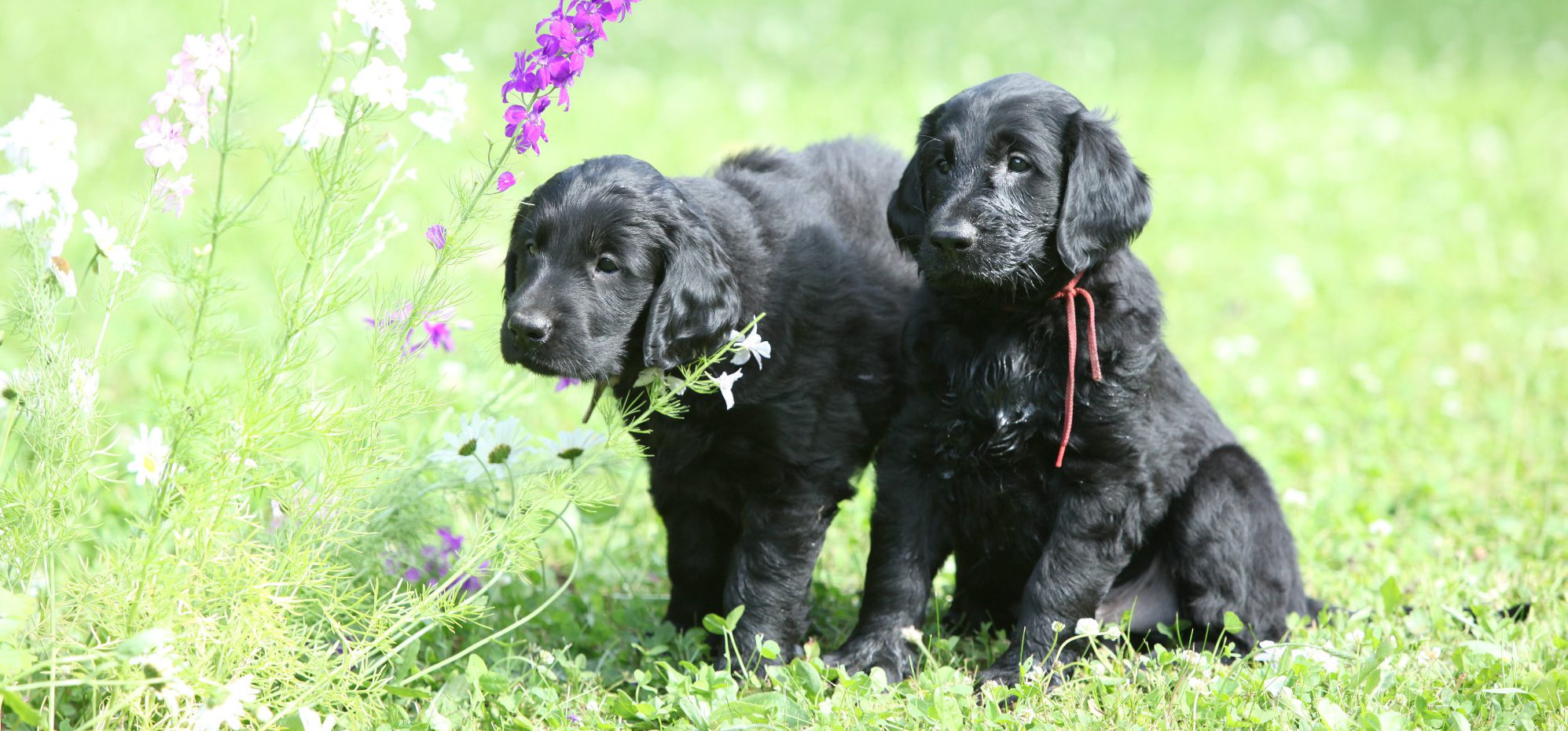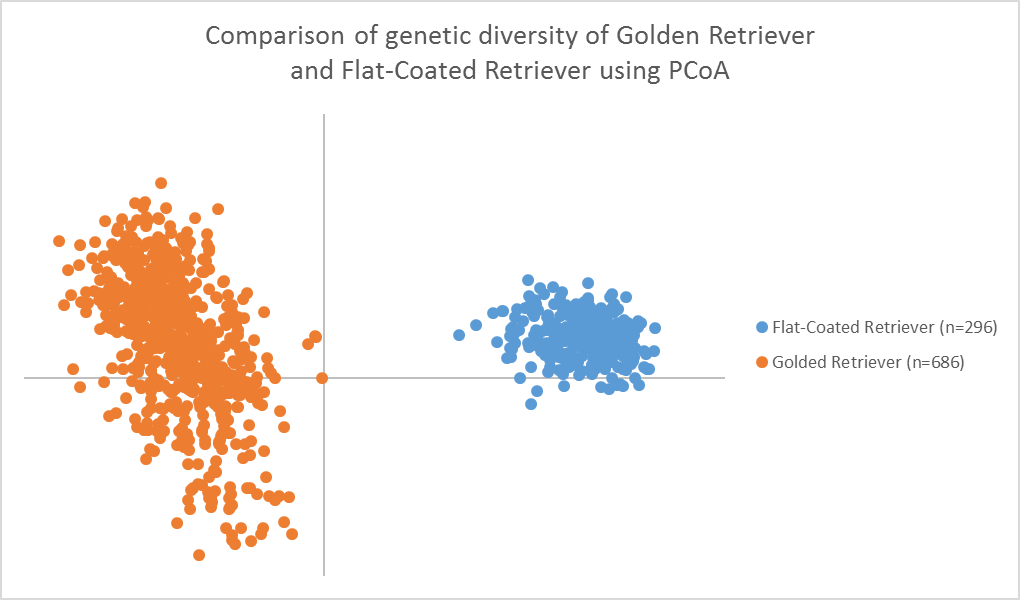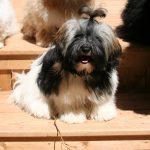
Real life stories – our unique help for breeders
Here’s a real life example of how BetterBred offers unique information you can’t get elsewhere. I’m going to number those unique things as we go – so look for the #s.
A couple weeks ago I was helping a Flat Coated Retriever breeder who was new to our method. We are honored to have a lot of Flat Coats in the database, and lots of active breeders, and I am constantly impressed with the openness, cooperative approach and seriousness of that breed community. Their breed’s results reflect their care.
Flat Coated Retrievers as a breed have a very small gene pool (#1) but their existing genetic diversity is well distributed (#2.)

Each dot is a dog. This graph shows how genetically similar dogs in each breed are. Golden Retrievers have much more diversity, with a large mass of similar dogs. Flat Coats are mostly similar, with a few “genetic outliers,” the dots on the edge of the blue ball. Image courtesy of the UC Regents/UC Davis Veterinary Genetics Lab
This breeder had imported a bitch to North America from Eastern Europe in order to have something different. This breed community is very diversity minded. The breeder is very happy with this bitch. So we enter this bitch and two of her dogs into the system.
The bitch turns out to be fairly inbred, much more so than breed average (#3,) but more importantly she is highly typical for the breed (#4.) We know this because we have two different measures for assessing that (#5) and both show she’s highly typical. What does that mean? It means that her ancestry is highly influenced by the most common, well used and important founding dogs in the breed. These can be more recent popular sires in some breeds, or the original founders of the breed, depending on the history of the breed and the habits of the breed community. Why does that matter? Because good or bad, these common dogs in each breed are more easily found, usually all over the world. Breeders import dogs they believe they can’t get nearby, so the expense and trouble of importing a dog should hopefully provide some diversity for the importer’s program.
In this case, this Flat Coat bitch is herself high quality, but nevertheless is not different from lines in North America. The breeder wants to assess a potential mating with a particular dog. We have a free app that estimates the genetic relatedness between two dogs (#6) based on the DNA results and well documented conservation methods. So we look at how this imported bitch matches up with the dog this breeder likes. What she doesn’t understand yet is that this other dog is also highly typical for the breed – which we know from his publicly available, free analysis. So I am not surprised when BetterBred’s software shows that these two are as genetically similar as full siblings – but this breeder sure is. And she’s upset to see it, but also relieved to know it. Based on a pedigree analysis, the two would seem highly unrelated. Luckily, one of the breeder’s dogs is genetically unrelated to the bitch, so all is not lost, though ideally she wants a different type of mate for her, so she’s still looking for the perfect stud.
With our subscription software, breeders can also simulate litters (#7) and all litter results have ranges of both inbreeding and of how typical for the breed they can be. We now have dozens and dozens of actual litters that were planned on BetterBred and tested after arrival, and the ranges are proven accurate. (#8) These simulations allow breeders to estimate how much risk they may have in their litters, since it has been scientifically proven that rates of breed specific diseases rise with severity of a genetic bottleneck. So for complex diseases that have no DNA test and that are breed specific (more frequent in a specific breed), dogs with more bottleneck influence have higher risk – even when they are outbred. This is because not all breed specific diseases are recessive, and inbreeding based solely on estimates of homozygosity can only estimate risks for recessive, single locus disease. Breeding solely for heterozygosity will not help with breeding away from autosomal dominants or complex disease genes.
So let’s say that our breeder friend breeds her imported bitch, and has a litter of puppies. Let’s say she tests all the puppies and also assesses their type and temperament. Out of her picks, there’s a puppy that’s not as typical as the dam and or as inbred. The quality of the puppy is the same or better than her dam. One of the picks is as typical and as inbred as the dam, with quality the same or better. Breeder picks the less typical puppy and has made a step forward for her own program, and also benefits the breed as a whole because she does not further contribute to any breed bottleneck. This helps maximize the retention of genetic diversity and helps preserve the breed (#9.)
Or, let’s say there are two comparable puppies that are both improvements on the highly typical dam, but it’s hard to choose which to keep. By looking at all the relationships between those puppies and specific other dogs in the breed, this breeder can tell that one puppy is more genetically like a particularly lovely grandparent’s line. The other puppy is more like the line she’d prefer to breed away from – so the choice in puppies is easier to make (#10.)
And then let’s say she wants to breed one of these bitch pups to a specific dog or frozen semen she has stored, and she wants to know which would be the best match. She can plan potential breedings long before she decides on a keeper pup (#11.)
So that’s a real life example of how BetterBred works. We have been doing this now for over 2 years and are growing very quickly because we provide something to our members that is both necessary and unique. We use this method ourselves, after years and years of needing this exact kind of help for our breed.
There are no silver bullets. There are no guarantees. Disease testing is very important, but we can’t “purify” a whole genome. Finding individual genes one by one for forever will not solve all ills, because new ones are always appearing and research takes longer than a dog generation or two. Inbreeding and line breeding also won’t solve all ills, or we would not have any problems in the highly linebred breeds. Outcrossing and outbreeding will not solve all ills, or mixed breed dogs would never be sick. Breeding high quality, functional, healthy domestic species takes great skill, and care, is multi-factorial and requires gradual, steady change.
Most importantly, the people DOING this are breeders, not geneticists. Breeders’ needs and immediate goals are different, and so our tools have to be geared to helping breeders contribute positively to their gene pools in each generation.
 Previous Post
Previous Post Next Post
Next Post


